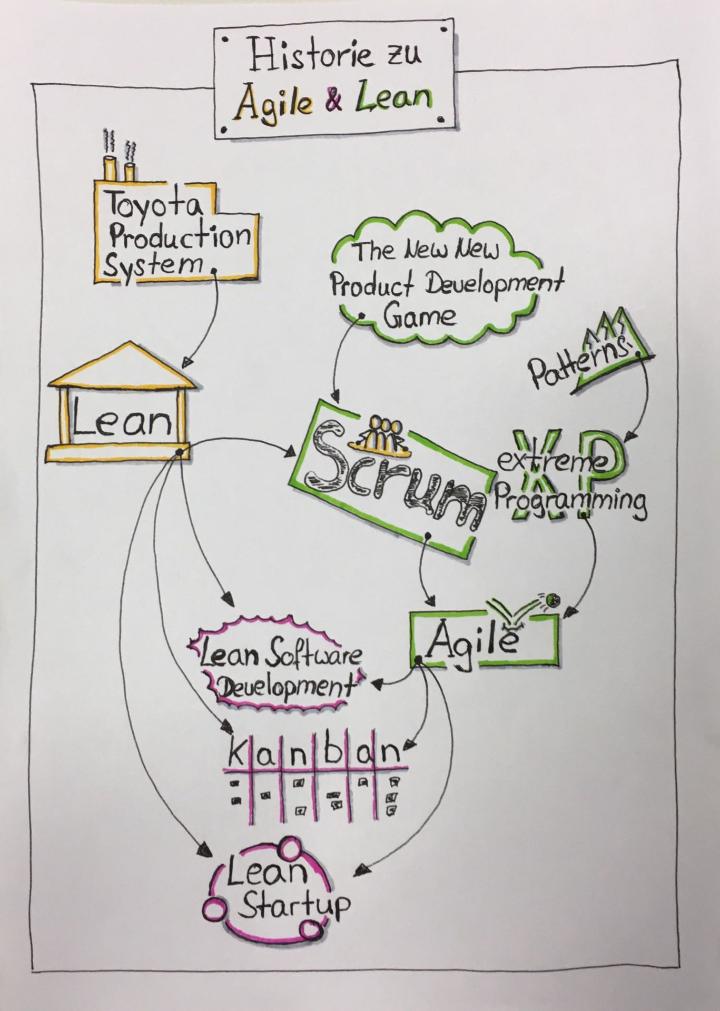What can I say about the flipchart?
Toyota Production System
The history of the Toyota Production System (TPS) began at the beginning of the twentieth century with the invention of an automatically stopping loom by Toyoda Sakichi (Jidoka, i.e. automation with a human touch). His son Kiichiro Toyoda, founder of the Toyota Motor Corporation, took up these ideas and continuously developed them further in the context of vehicle production (just-in-time, kaizen). From 1948, it was above all Taiichi Ohnothe production manager at the time, who combined these ideas, developed them further and thus created the TPS. The main objective is high productivity with maximum quality and short throughput times, which is achieved primarily through the consistent elimination of waste (muda in Japanese). The TPS is considered "the" predecessor of Lean.
Lean
The term "lean" was first used in 1988 by the Article "Triumph Of The Lean Product System" by John Krafcik coined. What is understood today by the term lean (lean thinking, lean production) is primarily based on the books "The Machine That Changed The World" and "Lean Thinking" from James P Womack, Daniel T. Jones from the 90s. Based on these two works, 5 fundamental lean principles have emerged:
- Define value from the customer's perspective.
- Identify the value stream for each product that delivers that value. Question all wasteful steps that are currently required to deliver the product.
- Ensure a continuous flow for the remaining value-adding work steps.
- Introduce a pull system between the work steps.
- Always strive for perfection with the aim of continuously reducing the number of work steps, throughput times and the amount of information required.
The New New Product Development Game
The article "The New New Product Development Game" by Hirotaka Takeuchi and Ikujiro Nonakapublished in the Harvard Business Review in 1986, describes a new approach to manufacturing new products. They compare their approach to the rugby formation "Scrum", in which a team works together to achieve a goal (pushing the ball over the line), which contrasts with sequential product manufacturing, which is more akin to a relay race. This article was the definitive template for Scrum.
Scrum
Scrum was developed by Jeff Sutherland and Ken Schwaberbased on "The New New Product Development Game" and first presented publicly by them at the "Object Oriented Programming, Systems, Languages and Applications" (OOPSLA) conference in 1995. In the years that followed, the two collaborated and incorporated their experiences and good practices to make Scrum what it is today: the most popular agile approach. The latest update of the Scrum Guide took place in 2020.
Patterns
In August 1993, the company sponsored Kent Beck and Grady Booch a conference in the mountains of Colorado with selected experts to define design patterns for object-oriented software development. In addition to the initial work results, the so-called Hillside Group was founded as an organization to ensure the further development of the patterns. The patterns and practices were taken up by extreme programming, among others.
Extreme Programming
eXtreme ProgrammingXP for short, is a software development method developed by Kent Beck with the support of Ward Cunnigham and Ron Jeffries was developed during the "Chrysler Comprehensive Compensation System (c3)" project and published in 1995. The primary intention of the approach is to increase software quality and responsiveness to changes in requirements. To achieve this, XP relies on short development cycles and frequent releases. The good practices of XP, such as pair programming or test-driven development, are also used in other (agile) approaches today.
Agile
Agile describes the superset of all agile approaches that originate primarily from the field of software development, such as Scrum, extreme programming or feature-driven development. The term was coined by the "Manifesto for Agile Software Development (Agile Manifesto)", which was published in 2001. Today, agile approaches are also used outside of IT, for example in the development of new products and services. Based on our experience, we at wibas have defined 5 fundamental agile principles:
- Empowered and self-organized teams
- Early and regular delivery
- Inspect and adjust
- Transparency
- Bar (timebox)
Lean Software Development
Lean software development is a transfer of lean principles and practices to the domain of software development. The term comes from the book of the same name "Lean Software Development: An Agile Toolkit" by Mary and Tom Poppendieck. Above all, this book describes the connection and relationship between Agile and Lean.
Lean Startup
Lean Startup is an approach to developing business models and products for a volatile market in which customer needs are generally not sufficiently known. It is based on the book of the same name by Eric Ries from the year 2008. The approach is characterized by short hypothesis-driven cycles in which experience-based learning takes place at the end to determine that you are on the right track or that you need to pivot.
Kanban
Kanban for software development was introduced in 2010 by David J. Anderson with his book "Kanban - Successful Evolutionary Change For Your Technology Business" to the public for the first time. The book is the result of his experiences during a project assignment at Microsoft in 2004. The approach combines Kanban from production, lean principles, ideas from bottleneck theory and drum-buffer-rope. Kanban is becoming increasingly popular these days and is often combined with Scrum (Scrumban) to provide better methodological support for DevOps teams, for example.
What does the flipchart finally look like?



Write a comment